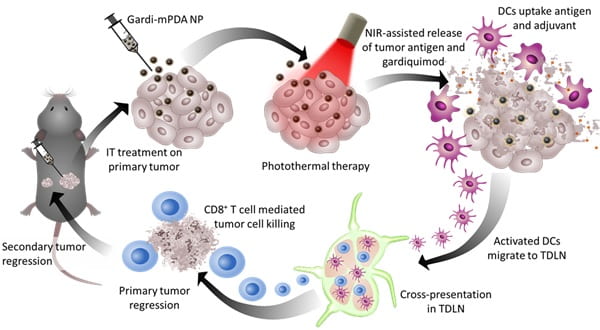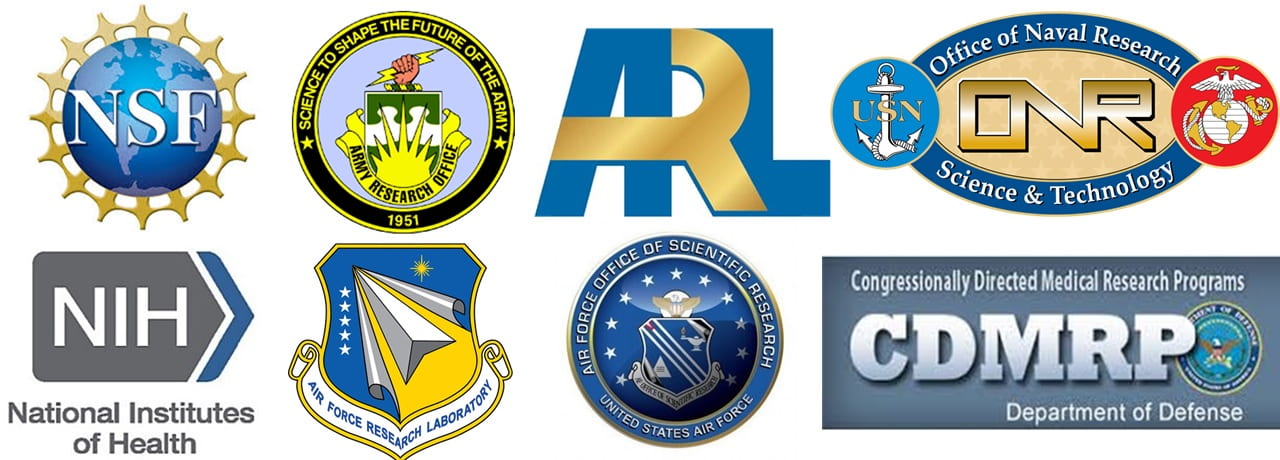Soft Nanomaterials Lab: Research Focus
Multifunctional Nanostructures for Cancer Immunotherapy: Cancer immunotherapy involves a cascade of events that ultimately leads to cytotoxic immune cells effectively identifying and destroying cancer cells. Responsive nanomaterials, which enable spatiotemporal orchestration of various immunological events for mounting a highly potent and long-lasting anti-tumor immune response, are an attractive platform to overcome challenges associated with existing cancer immunotherapies. We design, synthesize and validate novel multifunctional nanostructures for (i) efficiently administering immunotherapy; and (ii) early detection of the cytotoxic potential of the intra-tumor T cells. In addition to improving the therapeutic efficacy, we aim to assess the efficacy of immunotherapy treatment in patients at an early time, sparing patients the side effects of the therapy and the financial burden (to the insurance industry and/or patient) of continued but non-durable treatment. This strategy is applicable to any therapeutic option employing immunotherapy alone or immunotherapy in combination with conventional chemotherapy.

Novel plasmonic nanostructures and assemblies for theranostics: Owing to the unique combination of physical, chemical and biological properties such as large absorption and scattering cross-section, high sensitivity to local dielectric environment and enhanced electric field at the surface, metal nanostructures are emerging as an important class of materials for nanomedicine. However, there are several fundamental scientific challenges that need to be addressed before plasmonic materials can make an impact in clinical settings. We have specifically focused on surface enhanced Raman scattering (SERS) as a bioimaging modality for spectrum- or image-guided surgical tumor resection. One of the key challenges in this field is the limited brightness of the SERS probes that are employed as exogenous contrast agents for SERS-based bioimaging. We addressed this issue by introducing several simple and robust chemical methods for achieving ultrabright SERS probes by either trapping Raman reporters between core-satellite assemblies of gold nanostructures or by sandwiching Raman reporters between gold core and shell of core-shell nanoparticles. Furthermore, we have demonstrated the integration of such bright probes in drug delivery vehicles for image-guided locoregional cancer therapy.

Photothermal materials, interfaces and applications: Materials that efficiently harvest light and convert it to heat are finding numerous applications in energy harvesting, desalination, and biomedicine. In most of these cases, interfacing highly efficient photothermal materials with conventional materials (e.g., water purification membranes, drug delivery vehicles, dermal patches for transdermal delivery) to realize novel functional materials is an exciting research area. Our lab has extensive expertise in the design and utilization of such photothermal materials and systems in various applications including solar steam generation, anti-biofouling, photothermal membrane distillation, and externally triggered payload delivery from porous scaffolds and nanostructures.

Organic-inorganic hybrid materials for biopreservation: Novel materials and technologies for handling, storage and transport of biomolecules (e.g., biospecimens, diagnostic reagents, and protein therapeutics) are urgently needed to accelerate and extend the benefits of biomedical advances to underserved populations. Our lab has extensive expertise in the design and validation of novel materials and strategies (e.g., organo-silica encapsulation, in situ nucleation and growth of metal-organic frameworks) for preserving the functionality of immobilized and soluble biomolecules. In most of these applications, the interfacial interactions between the biomolecule and abiotic material is critically important. We utilize state-of-the-art analytical techniques to understand the structure and properties of biomolecules at these surfaces and interfaces.

Materials and interfaces in unconventional neuromodulation technologies: Recording the electrical activity and possibly controlling a selective population of neurons to understand and influence the behavior and possibly enhance human capabilities is a grand challenge in systems neuroscience. While the optogenetic techniques and other optical neural control techniques are promising, there are still several limitations associated with these techniques that remain to be addressed. On the other hand, recent reports indicate that functional nanomaterials can serve as a non-genetic and possibly more universal tool for achieving this. We are interfacing (through selective targeting strategies) plasmonic nanostructures with neuronal cells for modulating the neural activity and possibly control the behavior of model organisms such as insects.
Research Support
